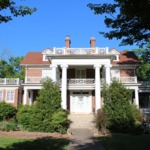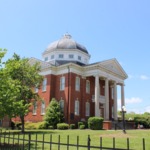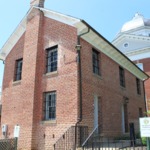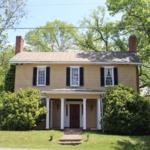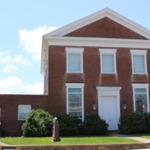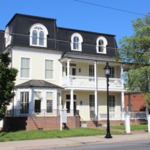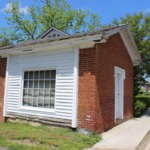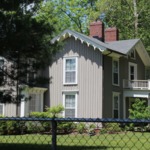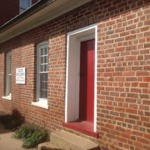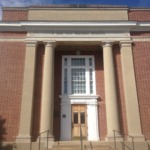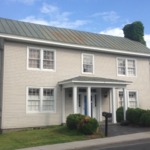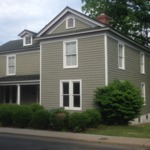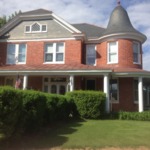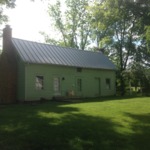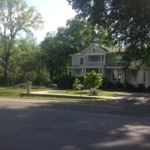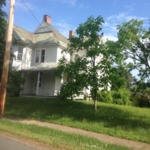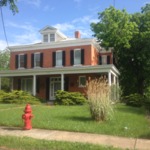Town of Louisa Walking Tour
Dublin Core
Title
Town of Louisa Walking Tour
Description
The County of Louisa was formed from Hanover County in 1742, and named for Princess Louisa, daughter of King George II and Queen Caroline of England. The meeting of the first Court was held on December 13, 1742 at the home of Matthew Jouett.
In 1836, the railroad reached the Louisa Courthouse. This began contact with the outside world for what had been a land locked settlement.
The Town of Louisa was incorporated under chapter 125 of the acts of the General Assembly 1872-1873, and approved on March 8, 1873. In 1878, 12 oil street lamps were installed around the business district. W. H. Vaden made rounds each morning, and evening to trim the wicks and light the lamps.
In January of 1888, the Town was struck by a devastating fire. Leaving most of the business district in ashes. It took time for the Town to be rebuilt, but when construction began brick replaced many of the wooden buildings.
Until the early 1900’s the sidewalks along Main Street were mostly plank. Tanbark walks covered the outlying areas. A bond issue in 1906 brought cement sidewalks to the town. From the late 1890’s until into the 1920’s Louisa was known as a summer resort for the fresh country air and the good southern food. This was before the advent of better roads and the automobile.
In 1836, the railroad reached the Louisa Courthouse. This began contact with the outside world for what had been a land locked settlement.
The Town of Louisa was incorporated under chapter 125 of the acts of the General Assembly 1872-1873, and approved on March 8, 1873. In 1878, 12 oil street lamps were installed around the business district. W. H. Vaden made rounds each morning, and evening to trim the wicks and light the lamps.
In January of 1888, the Town was struck by a devastating fire. Leaving most of the business district in ashes. It took time for the Town to be rebuilt, but when construction began brick replaced many of the wooden buildings.
Until the early 1900’s the sidewalks along Main Street were mostly plank. Tanbark walks covered the outlying areas. A bond issue in 1906 brought cement sidewalks to the town. From the late 1890’s until into the 1920’s Louisa was known as a summer resort for the fresh country air and the good southern food. This was before the advent of better roads and the automobile.
Collection Items
The Boxley Place Inn - 1860
Built in 1860 by Edwin Lee Smith, a local dentist. The house was sold in 1913 to the Boxley family.
In 1918 architect D. Wiley Anderson remodeled the home for the Boxley family. The renovations included: the addition of a dining room, a kitchen,…
In 1918 architect D. Wiley Anderson remodeled the home for the Boxley family. The renovations included: the addition of a dining room, a kitchen,…
Louisa County Courthouse - 1905
The current Courthouse was built in 1905 it’s the fourth in a series of Courthouses standing as the centerpiece of the town. A Colonial Revival Structure, it was designed by D. Wiley Anderson an accomplished Architect from Richmond. The stone…
Louisa County Jail - 1868
The jail was the fifth for the county operating from, 1868 to 1967. It was constructed in 1868 after a fire in which an inmate almost died burned the interior of the previous jail. This happened to several of the earlier jails as well. The bricks,…
Flannagan/Ely House - 1859
This beautiful eighteenth century home is believed to be one of the oldest buildings in the Town. It was once a part of the “Courthouse Tract†land that was sold in 1807 to Henry Lawrence. This was the longtime residence of Mrs. Ada Fannagan who…
United Methodist Church - 1852
Built around 1852 for the Louisa Methodist Episcopal Church and the upper story for the Masonic Day Lodge #58. After the Battle of Trevilian Station the wounded were brought here. The furniture was moved to serve as a makeshift hospital.
Cooke Office Building - 1887
The Cooke Office Building is a Victorian example of second empire architecture. It includes a mansard roof and an asymmetrical plan popular at that time.
Built in 1887 by Rice P. Cammack. Originally used as a hotel it was integral to the history…
Built in 1887 by Rice P. Cammack. Originally used as a hotel it was integral to the history…
St. James Episcopal Church - 1881
This quaint white church was built in 1881. It resulted through the efforts of Reverend James Grammer. One hundred years later it received full church status under the leadership of reverend John Von Hemert. The Parish Hall was added in 1961 (and…
Judge Lane's Law Office
This small brick building on Elm Avenue was the office of Judge Edward Lane. He was the first Circuit Court Judge for Louisa County from 1870-1879. His portrait hangs in the Circuit Court Courtroom.
Gable Manor/Rose Cottage - 1859
Gable Manor is a fine example of Gothic Revival design, a style influenced by the writings of Andrew Jackson Downing.
Judge Edward H. Lane, first Judge of the newly created Louisa County Court in 1870, built this house. Once called Rose Cottage,…
Judge Edward H. Lane, first Judge of the newly created Louisa County Court in 1870, built this house. Once called Rose Cottage,…
Crank Building - 1833
(Right of the Courthouse) Lucien Minor proposed in 1832 to build a lawyer’s office of brick on a twenty-foot square of public ground. It was approved and built the next year. The Crank Building was named in honor of W. Earle Crank. Mr. Crank…
R. Earl Ogg Memorial Building - 1917
Built in 1917, for the First National Bank, it is a prime example of Neo Classic architecture. In 1978, Louisa County bought the building and the next year it was dedicated as the R. Ogg Memorial Building. Mr. R. Earl Ogg sat on the board of…
Virginia Homes and Farm Office - 1859
In 1859, Cynthia and Susanna Jones owned this building. It was purchased and converted to a professional building by R. Jefferson Garnett.
Garnett Law Office - 1905
This house was built in the popular vernacular style, of the time. Dr. Frank L. Woolfolk originally owned it. R. Jefferson Garnett bought the land in 1981 and it is now Garnett Law Office.
Louisa Christian Church - 1851
Reverend James A. Gross organized Louisa Christian Church in January of 1851. In June 1849 Elisha Melton and his wife conveyed land for the church to be built. The church has been remodeled since it’s origin and has a quaint cemetery adjoining…
Hadder House - 1911
Built by the Leigh Brothers, as were so many of the finer homes in Louisa. H. Q. Dickenson was the first owner to be associated with the house. He proceeded to add the Flemish bond brick Victorian portion of the home, in the Queen Ann style.…
Boxley Cabin - 1700's
This rectangular structure built of logs and covered in clapboard is considered by experts to be built in the late 1700’s or early 1800’s. It has a gabled roof and three front doors. The use of this building was not known.
The House, and…
The House, and…
Memorial Baptist Church - 1849
Originally known as the Upper Goldmine Church that was organized in 1849 when the congregation of black and white members reached 223. The name was changed in 1885 to the Louisa Baptist Church.
Porter/Garnett House - 1881
Jesse J. Porter first owned the Porter/Garnett house. A confederate veteran, Mr. Porter was elected into office as Deputy Clerk in 1875, and served until his death in 1912.
Goodwin/Hale House
Purchased in 1891 by Weir Goodwin a Deputy Clerk of Court. The house stands on a site that some believe was once occupied by the Old Walton Tavern. This part of town around West Street was called “The Grove†for many years.
Chiles/McVay House - 1912
Walter D. Chiles a town merchant bought the property in 1912 from his brother in law Weir Goodwin. It is believed that he built the house where he lived for many years.
